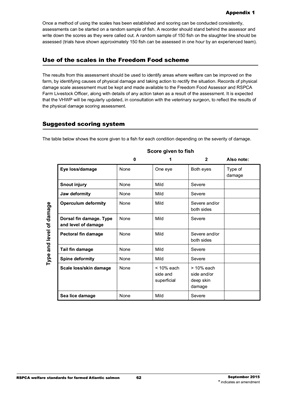
Appendix 1
RSPCA welfare standards for farmed Atlantic salmon 62 September 2015
* indicates an amendment
Once a method of using the scales has been established and scoring can be conducted consistently,
assessments can be started on a random sample of fish. A recorder should stand behind the assessor and
write down the scores as they were called out. A random sample of 150 fish on the slaughter line should be
assessed (trials have shown approximately 150 fish can be assessed in one hour by an experienced team).
Use of the scales in the Freedom Food scheme
The results from this assessment should be used to identify areas where welfare can be improved on the
farm, by identifying causes of physical damage and taking action to rectify the situation. Records of physical
damage scale assessment must be kept and made available to the Freedom Food Assessor and RSPCA
Farm Livestock Officer, along with details of any action taken as a result of the assessment. It is expected
that the VHWP will be regularly updated, in consultation with the veterinary surgeon, to reflect the results of
the physical damage scoring assessment.
Suggested scoring system
The table below shows the score given to a fish for each condition depending on the severity of damage.
Score given to fish
0 1 2 Also note:
Type and level of damage
Eye loss/damage None One eye Both eyes Type of
damage
Snout injury None Mild Severe
Jaw deformity None Mild Severe
Operculum deformity None Mild Severe and/or
both sides
Dorsal fin damage. Type
and level of damage
None Mild Severe
Pectoral fin damage None Mild Severe and/or
both sides
Tail fin damage None Mild Severe
Spine deformity None Mild Severe
Scale loss/skin damage None < 10% each
side and
superficial
> 10% each
side and/or
deep skin
damage
Sea lice damage None Mild Severe